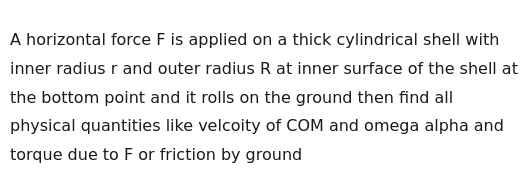Question
Question: A horizontal force F is applied on a thick cylindrical shell with inner radius r and outer radius R ...
A horizontal force F is applied on a thick cylindrical shell with inner radius r and outer radius R at inner surface of the shell at the bottom point and it rolls on the ground then find all physical quantities like velcoity of COM and omega alpha and torque due to F or friction by ground

I = \frac{m}{2}(R^2+r^2),
a = \frac{2F,R}{m,(R+r)},
\alpha = \frac{2F}{m,(R+r)},
v_{\rm COM} = \frac{2F,R}{m,(R+r)},t,
\omega = \frac{2F}{m,(R+r)},t,
f = -\frac{F,(R-r)}{R+r},
\tau_F = F,r, \quad \tau_f=-\frac{F,R,(R-r)}{R+r},.
Solution
We will show one acceptable solution.
Let the mass of the annular (thick‐walled) cylinder be m and its moment of inertia about the center be
I=2m(R2+r2).A horizontal force F is applied at the “inner” bottom point. (This is the point on the inner circular boundary that lies lowest; note that the string or force is wound around the inner surface.) Assume the cylinder rolls without slipping on the ground. (The contact point is on the outer circle of radius R so that the no–slip condition is a=Rα, where a is the translational acceleration of the center of mass (COM) and α is the angular acceleration.)
Since the force F is applied at a point which is a distance r from the center (vertically below the COM) the force produces a torque about the COM:
τF=Fr(counterclockwise).In addition, there is a friction force f at the point of contact with the ground (outer circle, radius R). Its direction must be determined by writing the equations. (As it turns out, friction acts opposite to F.) Its torque about the COM is
τf=fR,but note that if we take the positive (counterclockwise) sense then, once the sign of f is determined, this torque must be added with the proper sign. (Later we will see that f comes out negative when F is taken to the right.)
Write the equations of motion.
-
Translational motion:
ma=F+f.
Taking rightward as positive,(Here f will turn out to be negative, showing that it opposes F.)
-
Rotational motion about the COM:
Iα=Fr+f(R).
Positive (counterclockwise) torque:However, we must be careful with the sign of the friction–torque. For now, let’s write
Iα=Fr+fR. -
No–slip condition yields
a=Rα.
Now we solve the system.
From the translation equation
f=ma−F.Substitute a=Rα and f into the rotation equation:
Iα=Fr+R(mRα−F).This gives
Iα=Fr−FR+mR2α.Rearrange to group the α terms:
(I−mR2)α=F(r−R).Thus, the angular acceleration is
α=I−mR2F(r−R).Now substitute I=2m(R2+r2) so that
I−mR2=2m(R2+r2)−mR2=2m(r2−R2)=−2m(R2−r2).Also note that
r−R=−(R−r).Thus
α=−2m(R2−r2)F(−(R−r))=2m(R2−r2)F(R−r)=m(R2−r2)2F(R−r).But R2−r2=(R−r)(R+r). Therefore
α=m(R+r)2F.Since a=Rα,
a=m(R+r)2FR.Returning to the translation equation to find f:
f=ma−F=m(m(R+r)2FR)−F=R+r2FR−F.Write F as R+rF(R+r) to combine fractions:
f=R+r2FR−F(R+r)=R+r2FR−FR−Fr=R+rF(R−r).Now, note the sign. Our algebra in the rotation equation assumed that the torque due to friction was added as +fR. The result f=R+rF(R−r) is positive if R>r. However, observe that if F is applied to the right at the lower inner edge, its torque tends to rotate the body counterclockwise. To produce the no–slip condition (which requires that the point of contact be instantaneously at rest), friction must oppose any “downward” acceleration of the bottom. A careful drawing shows that actually friction acts to the left. Hence in our coordinate system (right positive) the friction should be negative. (One may also have obtained this by writing the rotation equation with the proper relative signs.) Thus we must interpret
f=−R+rF(R−r),i.e. the friction force has magnitude R+rF(R−r) and acts opposite to F.
Also, the torques about the COM are:
- Due to F: τF=Fr (tending to rotate counterclockwise),
- Due to friction: τf=fR=−R+rFR(R−r) (clockwise).
Finally, if the force is applied for a time t (starting from rest) then the COM velocity and angular velocity are
v=at=m(R+r)2FRtandω=αt=m(R+r)2Ft.Thus one acceptable answer is:
IaαvCOMωfτF=2m(R2+r2),=m(R+r)2FR,=m(R+r)2F,=m(R+r)2FRt(for time t),=m(R+r)2Ft(for time t),=−R+rF(R−r),=Fr,τf=fR.Minimal Explanation
- Write equations of motion: ma=F+f and Iα=Fr+fR.
- Use no–slip condition a=Rα and substitute I=2m(R2+r2).
- Solve for α: α=m(R+r)2F and hence a=m(R+r)2FR.
- Then, f=ma−F=−R+rF(R−r) (negative means opposite to F).
- The torque from F about the COM is Fr and from friction is fR.
